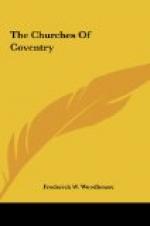No remains exist of the domestic buildings of the Friary.
The well-known Ford’s Hospital hard by is often called Grey Friars’ Hospital, but this arises merely from the situation. It was founded in 1529 by Mr. William Ford of Coventry, Merchant of the Staple, for five men and one woman, but is now inhabited by women only. It is an exceptionally beautiful example of Tudor timber construction in perfect condition.
THE WHITE FRIARS
The Carmelite or White Friars were, says Dugdale, fixed in Coventry in 1343 by Sir John Poultney who had been four times Lord Mayor of London. Although their buildings were ornate and extensive, their revenue apart from oblations amounted to only L3 6_s_. 8_d_. per annum and the whole came to less than L8. At the Dissolution the house and its revenues came eventually to John Hales, Clerk of the Hanaper to Henry VIII. Having amassed a great estate in monastery and chantry lands, Hales founded the Free School in Coventry, the Church of the White Friars being at first used for the purpose. Later, he made of the Friary a dwelling and removed the school to St. John’s Hospital, granted to him by the king in 1545. Part of the church of the Hospital still exists at the foot of Bishop Street, but the school has been removed to new buildings in the Warwick Road.
Of the buildings of the White Friars there are considerable remains incorporated with the Union Workhouse at the top of Much Park Street. The east walk of the cloister, 150 feet in length, has a fine groined roof of the fifteenth century. A range of vaulted apartments runs alongside the cloister on the east side, divided midway by the vestibule to the Chapter House now destroyed. The upper story above the cloister and the range of rooms was, we may assume, the friars’ Dormitory. A huge fireplace and a bay window are part of John Hales’ reconstruction. The gateway to the south-west corner of the cloister remains, and the outer gate of the precincts may still be seen in Much Park Street.
[Illustration: ST. MARY HALL.]
ST. MARY HALL
The Gilds were so important a part of the religious and social life of the city that it is imperative that some notice of their hall, which stands in suggestive proximity to the churches, should be given. St. Mary Hall, opposite the south side of St. Michael’s is one of the most complete and beautiful examples of a fifteenth-century town dwelling now remaining in England. It originally belonged to the Gilds of Holy Trinity and Our Lady to which were united at a later time those of St. Katharine and St. John Baptist, the oldest to be founded. By the fine groined gateway we enter the courtyard, on the south side of which is the kitchen, probably the hall of an older structure of the first half of the fourteenth century, the present hall and its undercroft on the




